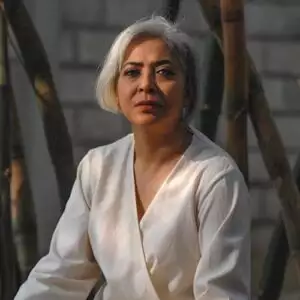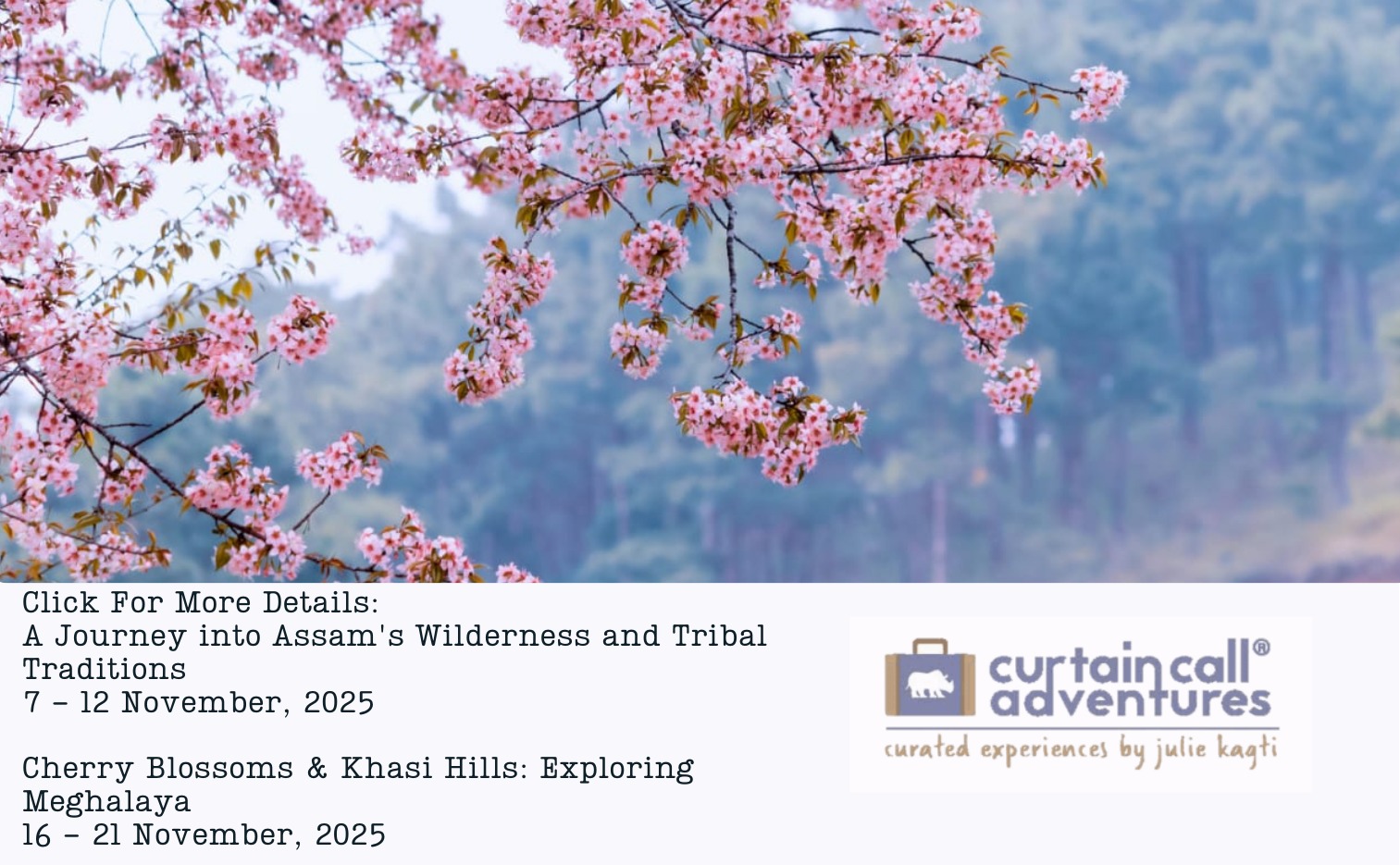I stood in the cool waters of the paddy field, a refreshing contrast to the humid morning even though the rain clouds gathered above, covering views of Western Bhutan, the high mountains. Vivid green of the young rice saplings stood out in the landscape of flooded mud fields all ready for the planting to start, where the local children played a boisterous game of football. I suspect it was the chance of getting caked in the cold muddy waters that was the main draw of the game. Their enthusiasm was contagious as older kids and adults started to join in and erect a net to play volleyball. The races and games soon began with young and old, girls and boys, local and visitors all participating with enthusiasm.
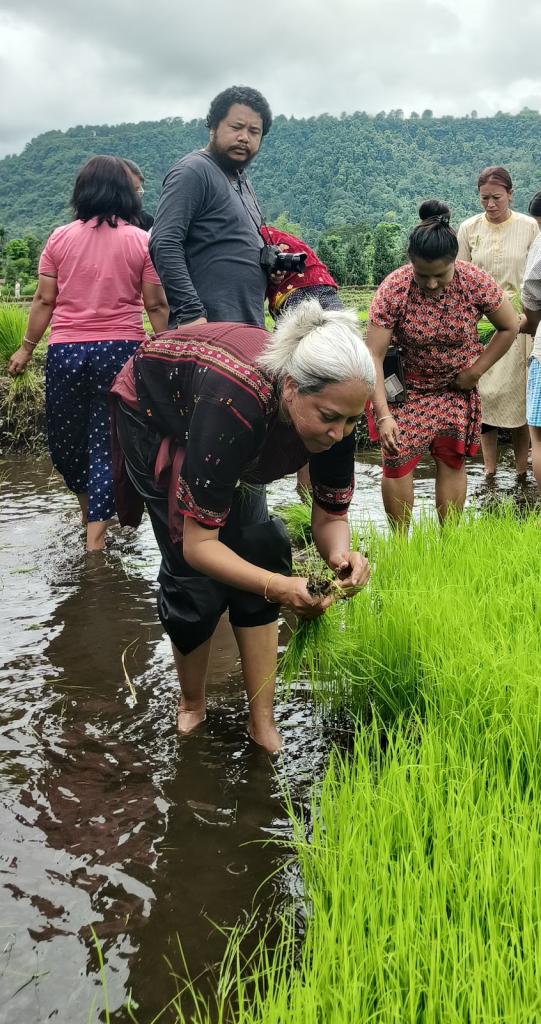
Led by the local women who showed us how to pull out the saplings without damaging the roots, singing while working, a bunch of us, visitors to the festival happily set to work while friends and cameramen surrounded us on one side clicking pictures.
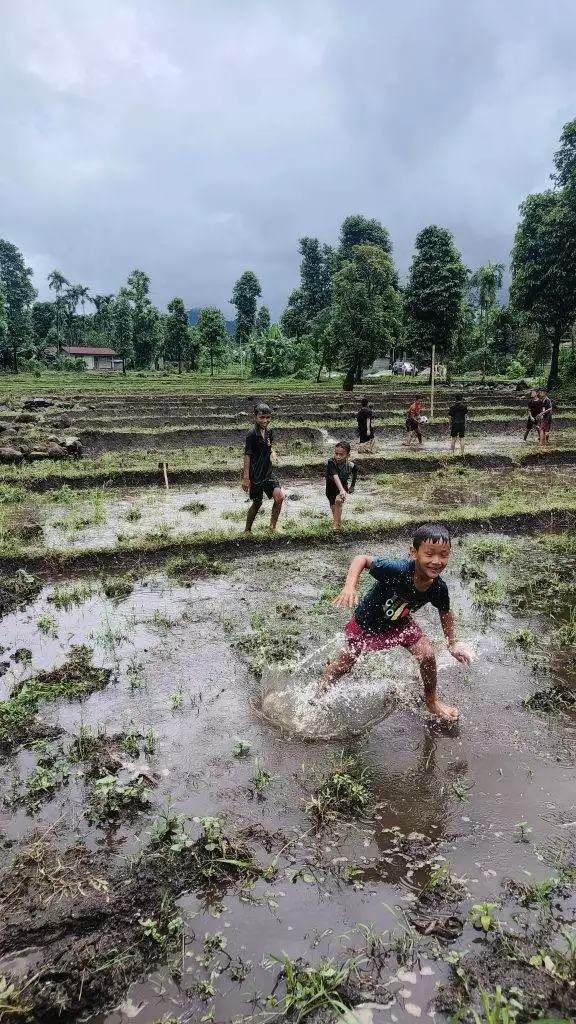
The local farmers who were ploughing the fields with their oxen let those who wished give it a go. In the dry ground nearby, ladies were setting up stalls selling local snacks, sweets, dumplings and home-brewed millet beer. Also, in the grounds was a makeshift museum made with natural materials showcasing their traditional farming equipment, a big tent set up to accommodate guests for lunch which the village hosted through their collective funds – a simple affair of rice, a chickpea curry with potatoes and bamboo shoot, vegetable stir-fried, yoghourt and spicy chutney.The World Wildlife Fund, Darjeeling team displayed posters on the local birdlife of the region and information on their red panda conservation efforts in a stall nearby.
A young girl carrying a very robust-looking rooster and shaking a bottle filled with corn seed walked up to everyone in the crowd with her friend to enlist entries for a ‘guess the number of seeds’ contest where the winner would be able to buy the rooster for a mere twenty rupees which otherwise cost about six hundred. They sure got a lot of entries!
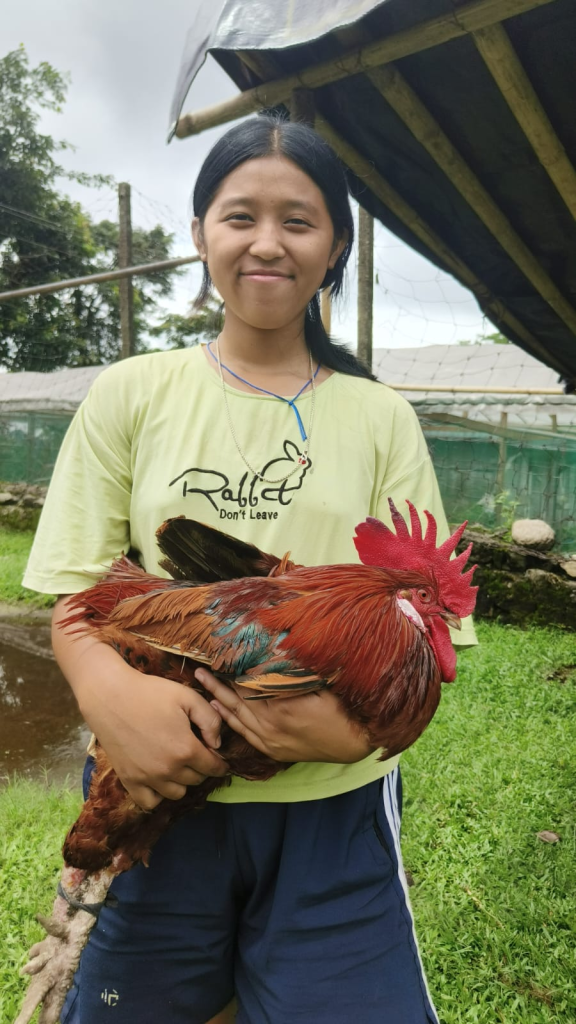

Roshan Rai’s words from two nights ago came to mind as I paused to absorb the moment. He is the Chairman of the Parengtar Nawlo Umang Welfare Society and the main man who along with Muhaan, a tourism initiative, envisioned this event three years ago. The heavy rain splattering us as we sat huddled in a circle with our phone torches on while lightning and thunder made the evening extremely poignant, he spoke with a lot of emotion about the history, traditional farming practices of the village, how other Nepali communities nearby, including some that live across the Jaldhaka river in Bhutan, used to help each other out but that has all changed in recent times. Many from his own small village here, Parengtar have abandoned farming for more lucrative jobs elsewhere. Children spend more time in school and commuting back and forth with very little knowledge of farming practices. A desire to have the community youth get a better understanding of farming practices and hence connect to both their culture and traditional farming, keeping it relevant while getting the village some recognition and extra income through rural community tourism led to annually hosting the Asar Pandhra festival since 2022. Asar Pandhra (pandhra means 15) is celebrated by all Nepali communities in the eastern Himalayan region as a festival marking the start of the paddy cultivation, and this year, as per the lunar calendar, it fell on the 29th of June.
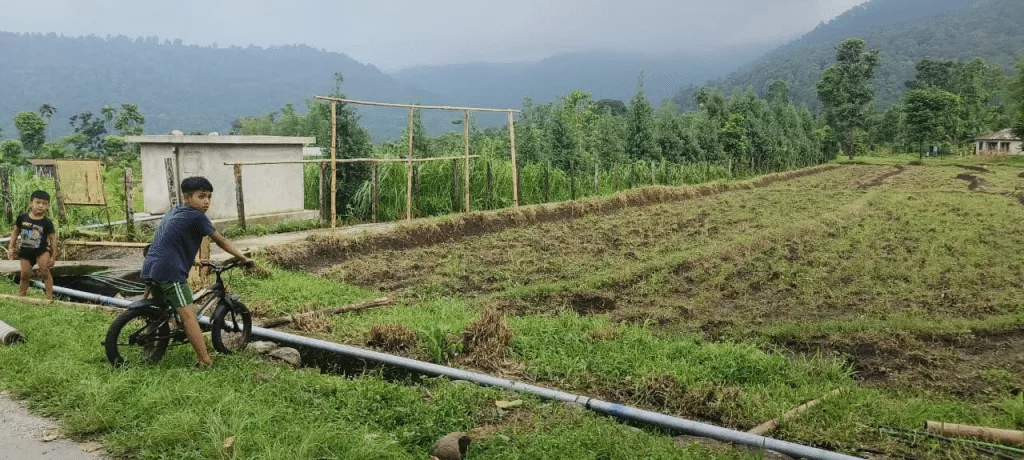
On a group call with Soniya Kirpalani, the creative force behind the Unknown Planet and Arunavh Dam of Muhaan, a grassroots community tourism initiative, I was introduced to the rice planting ceremony that annually happens at Parengtar village, set in a small valley of the lush forested foothills with very scenic views, Kalimpong district. They also host the harvest festival, Khole Dai, which successfully completed their 4th festival last year in December. Home to the Nepali Rai community, the Parengtar Nawlo Umang Welfare Society collaborated with Muhaan and Café Kalimpong to host the festival for tourists to come along and explore the ways of the village folks, see how they go about their daily routines where farming is a large part, and participate in planting the paddy, an activity I haven’t done since I was 7 years old!
As a travel curator who believes in promoting sustainable practices that benefit local communities, this was music to my ears. I was intrigued with the concept of community involvement and wanted to see it first-hand with the possibility of curating a monsoon tour around it. In later conversations, Roshan told me how initially the community was very hesitant to do so, and in the first year of Kholei Dai festival, only 3 homes agreed to host guests. This year for Asar Pandhra, 30 or so homes opened their doors for guests. Each of them provided one or two rooms with bedding, hot water, breakfast and dinner, plus time to chat with their guests about the village ways.
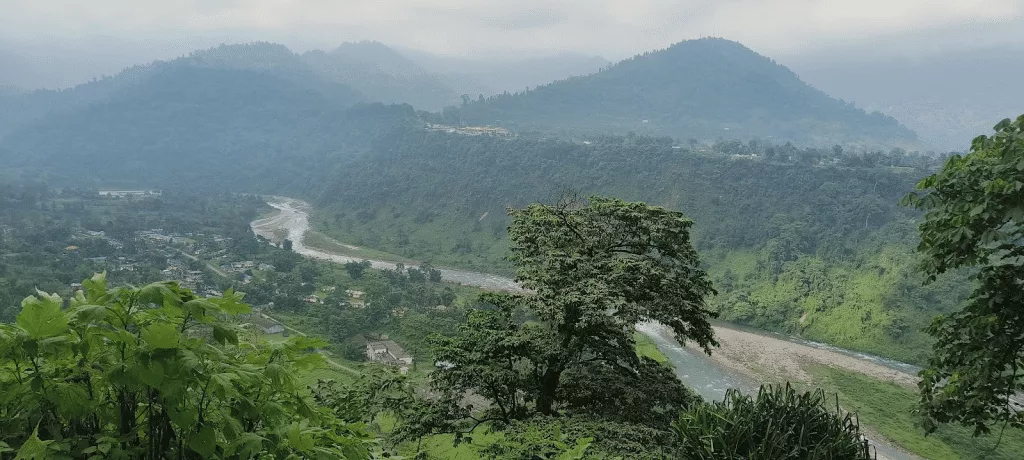
The drive to the small rustic hill village, about a 4-hour 30-minute drive from Bagdogra airport, took me through patches of forests, tea gardens of the Dooars region, small towns and views of the eastern Himalayas, all lush filled with ferns and wildflowers along the roadside, an advantage while travelling in the rainy season. I was introduced to different genres of Nepali music by my guide and fellow traveller, which resonates with the countryside. Everyone pointed out the hills of Bhutan as soon as they came into view. Parts of the road are in poor condition as road works are ongoing.
I had opted to stay in Mount Villa, a property that had five cottages where the owners graciously provided me delicious home-cooked dinners and conversations on places of interest nearby, even offering to take me on a short trek to a lovely viewpoint, which sadly we could not do due to the rains in the morning. They also offered me a peek into life here, especially during the monsoon, where power cuts are common and rain never-ending. I was surprised to learn that quite a few people from the village go abroad for employment, my host now on holiday works for a cruise liner based in Miami. My driver informed me that his wife works at an old-age home in Israel while he takes care of his elderly parents and young children, taxing people as and when possible, for income.
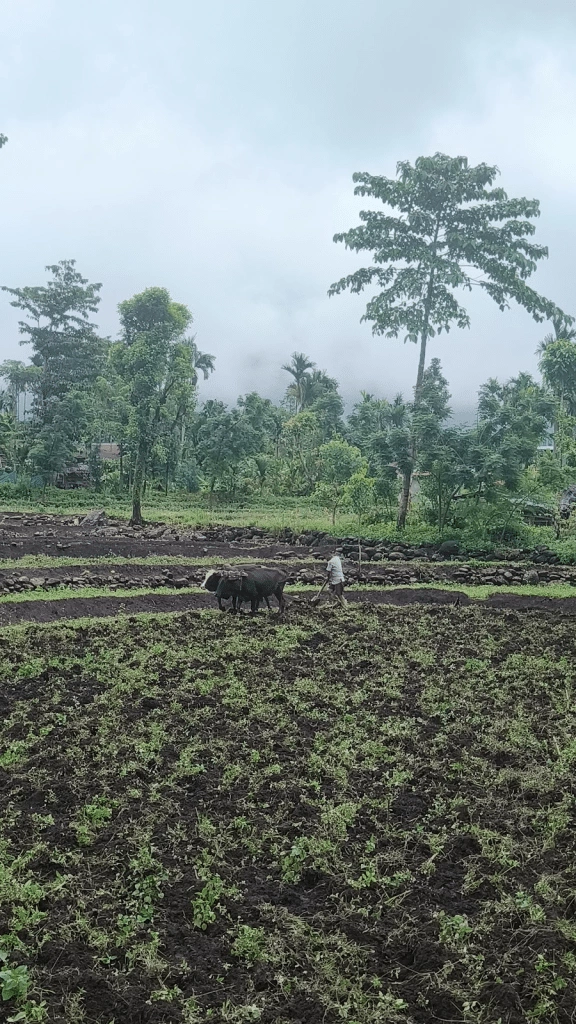
Next day, mid-morning on an hour’s walk along the paddy fields into the interior parts of the village with Prince, a 14-year-old boy who volunteered, I got a sense of the village. We walked past farmers ploughing their land, tiny houses with lovely flowering plants, kitchen gardens and small shelters for livestock, mainly chickens, sheep, goats and cows, met women cutting grass for their cattle, goats being taken out to feed in the grounds near the fields, families sitting in front yards playing and chatting with their children, small bamboo baskets dotted the sides of our narrow pathway which were used by locals to dispose of their plastic waste, people washing and drying fresh produce from their farmlands, a group of locals who had volunteered to make small bowls known as Tapara out of Ficus tree leaves for the customary offering of dahi – chewra (dry flattened rice) for the next day’s festivity. I was very impressed by the long, elongated bamboo V-shaped basket-like headgear with a plastic lining that the women were wearing to protect themselves from rain and sun. The last leg of our walk was to a ledge near the forest with scenic views of the river below. Mist and clouds drifting in and out with a slight drizzle falling made the view even more charming.
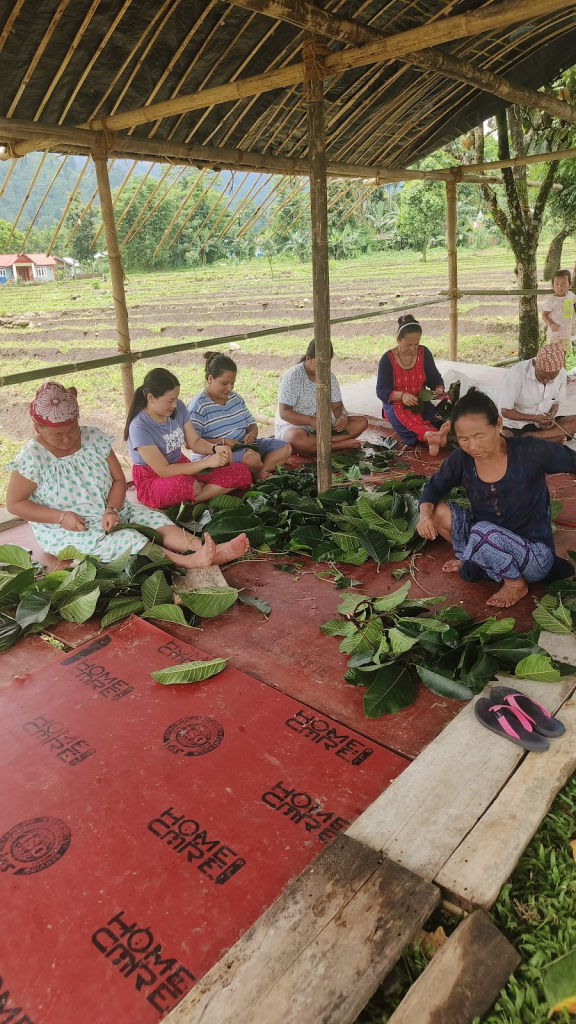
In the evening, we gathered in the community hall, thirty odd visitors, the team from Muhaan and the welfare society members, to introduce ourselves, share our impressions of the village, and on request, Roshan got me a bowl of raw rice that is grown here. Interestingly, the rice is not indigenous to the place as their older mother plants had perished, and the village council had introduced a new variety a few years ago. He also explained that millet is planted in the same fields after paddy, and when both are harvested, they plant corn. The evening could not end without a gathering in Basant Cafe, one of the two cafes that the village has, for plates of Masala Chana and home-brewed millet beer, which some kind soul had organised for us on request while the rain fell heavily, something that the locals are quite accustomed to as they go about their daily chores.
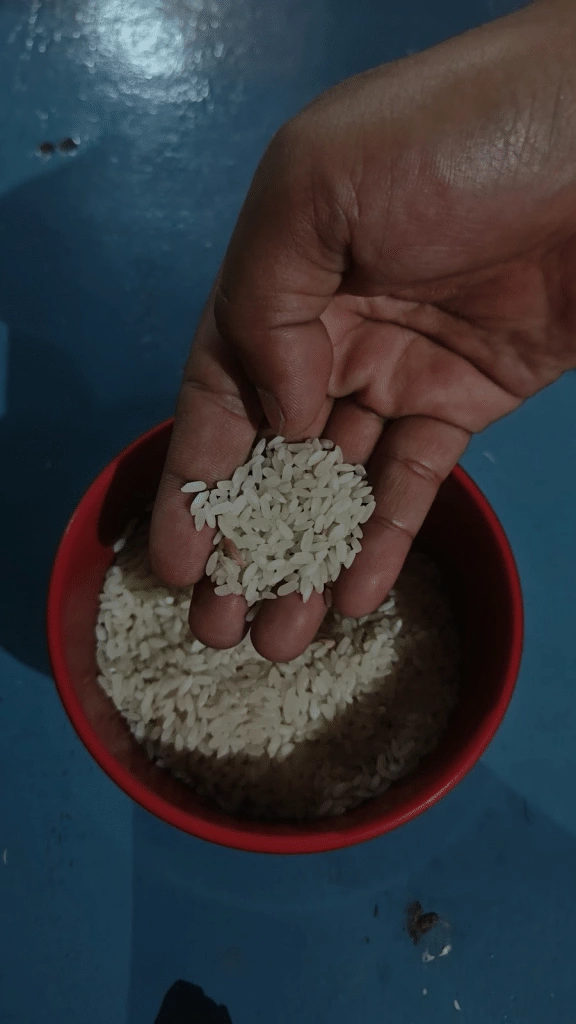
On the morning of the festival, the rain held up while two elders from the village offered prayers for a good crop this year. Meanwhile, tents were erected for those who wished to sit and observe the festivity, with the sound system placed in a corner where throughout the day, announcements were made on the various activities, winners of races, time to get saplings and start the planting, small speeches and music. Each visitor was invited by name to the tent where a member of the welfare society pinned a brooch, handmade with corn husk and a twig of the rice plant.
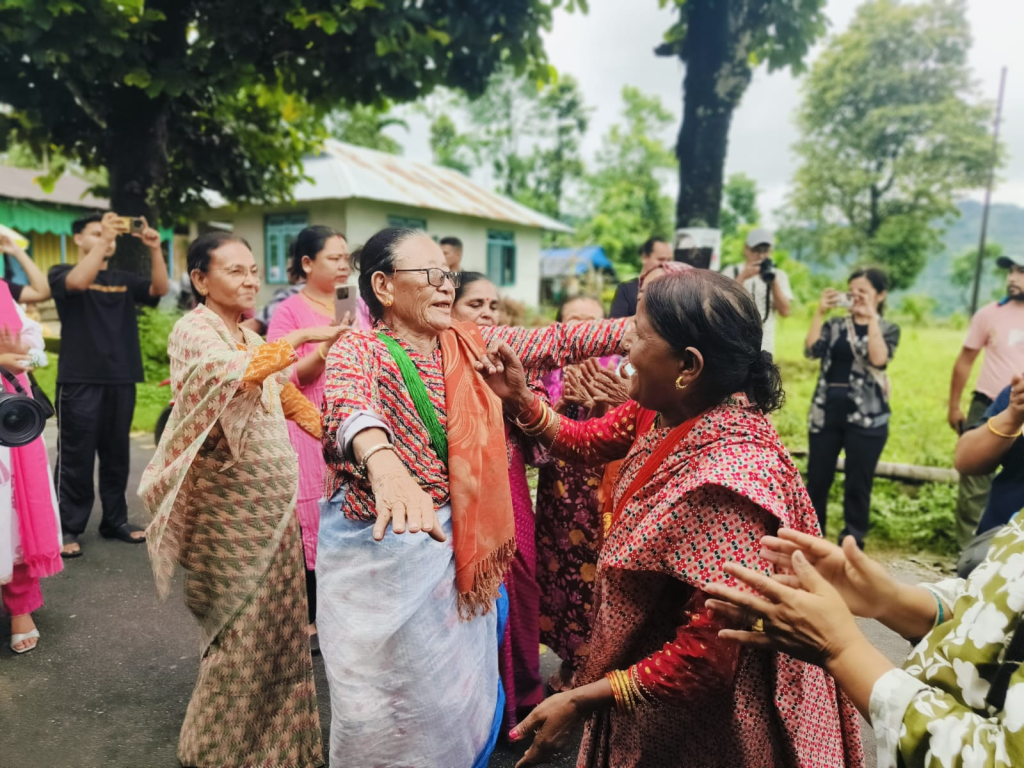
Soon, the elder ladies broke out in song and dance, joined by one or two men beating the dhol. Later, I sat next to one of the gentlemen as he performed for a few and enjoyed a philosophical chat on land, it’s importance in our lives for the bounty provided, which he equated to the turnout of about 600 people, mostly from nearby villages and towns, and the joy it brought him. How proud the community were that so many had heard about them hosting the festival and that outsiders had come to join in.
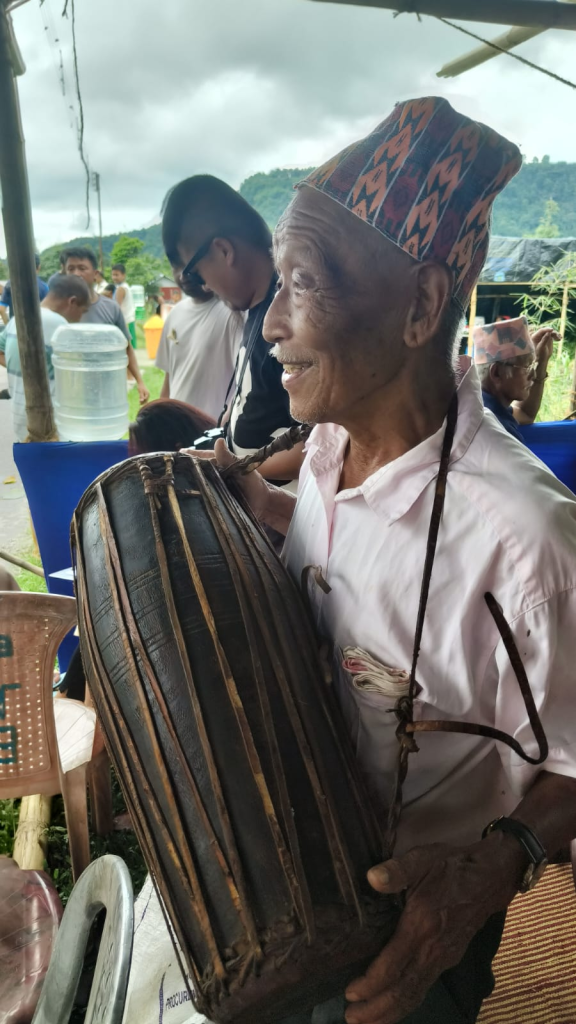
A small tent was set up nearby, from where a group of 2-4 ladies served everyone who came to the festival dahi chewra in the Tapara bowls, a must-eat for all attending the festival. Delicious as the yoghurt was sweetened, and later, I was told that each household that keeps cows, most do in Parengtar, contributed a few litres to make the yoghurt.
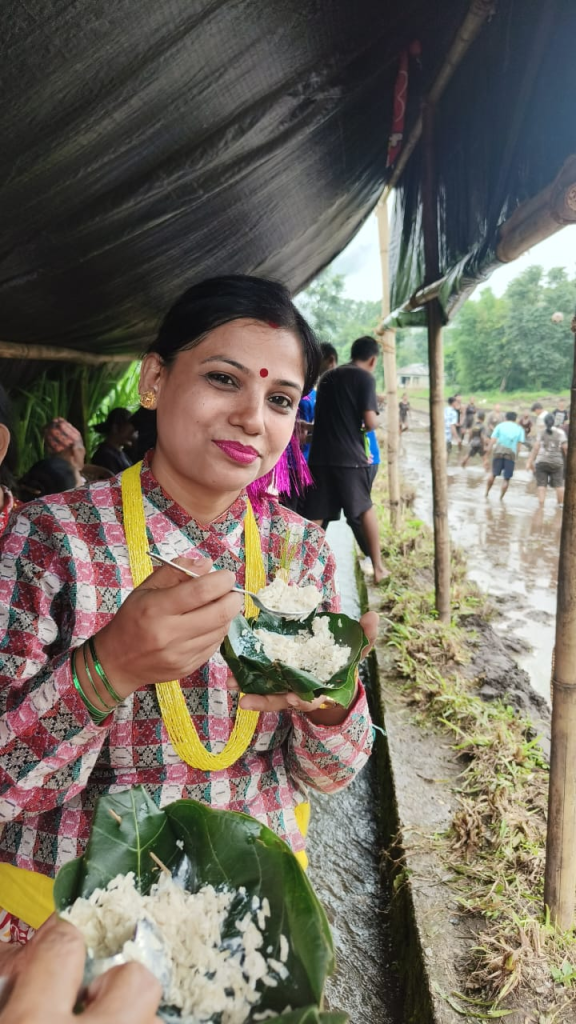
By then, the young children from the village with mischief in their eyes and brimming with broad smiles that made even strangers smile back took to the flooded paddy fields with their footballs. It was their playful challenge to all present to join them that thawed even the sceptics, and soon we were rolling up our trousers, setting our footwear aside, quite a few even went to change into their shorts and stepped into the fields – some to join the games, some to help with the planting process, or simply to feel the cool water of the rushing stream surrounding the fields. By late afternoon, after planting the saplings in the main field, I headed back to the cottage for a shower and rest. The games, singing, feeding, gentle rain falling continued till the early hours of the evening.
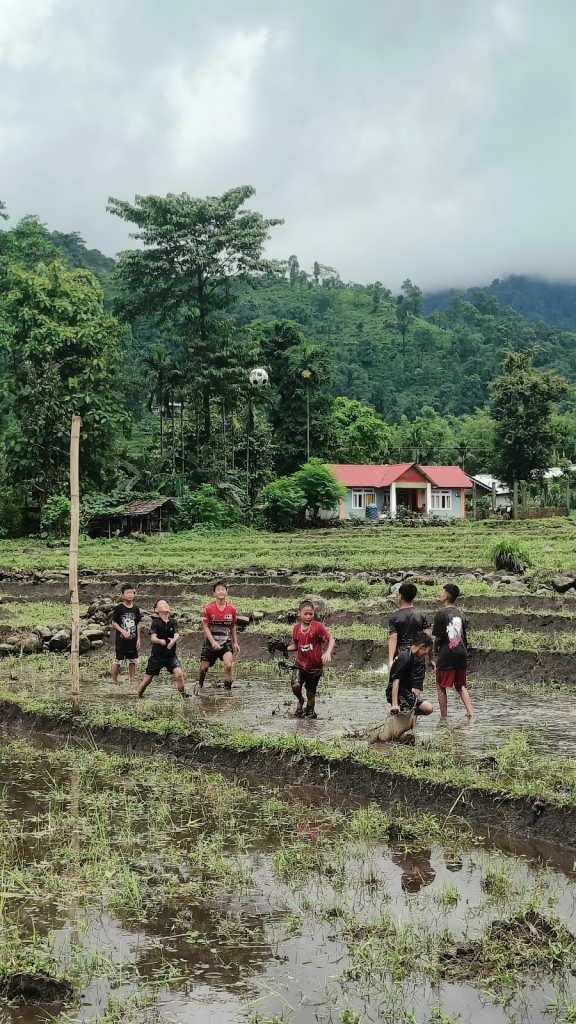
Later, when we gathered again in the community hall, the mood was sombre as we were still absorbing the day’s events and recognizing that now it was time to bid farewell. We exchanged thanks and impressions of the day’s festivity. The organisers gifted us bamboo pen holders crafted by an artisan at the nearby Todey Bazaar. A hot dinner was served for all guests in the grounds, by now the crowd had dwindled to a few. Rice, curried chicken soup, bamboo shoot curry and chutney with the servers willing to pile on more, we ate, exchanged numbers and made plans to keep in touch.
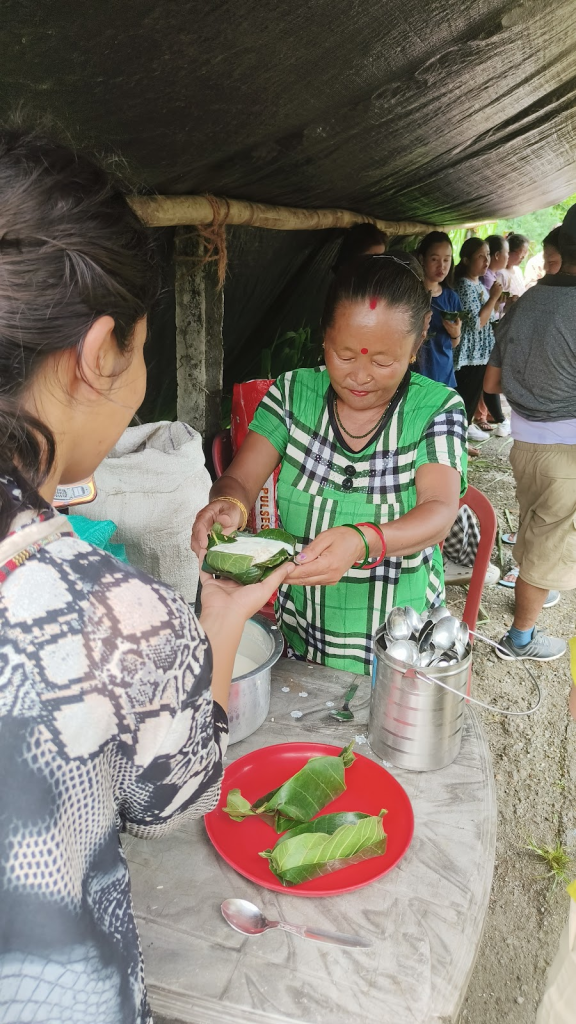
Small gestures by the community are really at the soul of this rustic festival, connecting everyone present with the rain, earth, and planting paddy together, an integral part of diet. Gently practised and shared with enthusiasm, this charming quaint village community living in the Eastern Himalayan foothills along with their tourism partners is truly spearheading sustainable agro-tourism to better their income, retain a cultural identity, and offer a rare experience to the discerning traveller. A conscious awareness of the circle that connects weather, nature, and mankind.
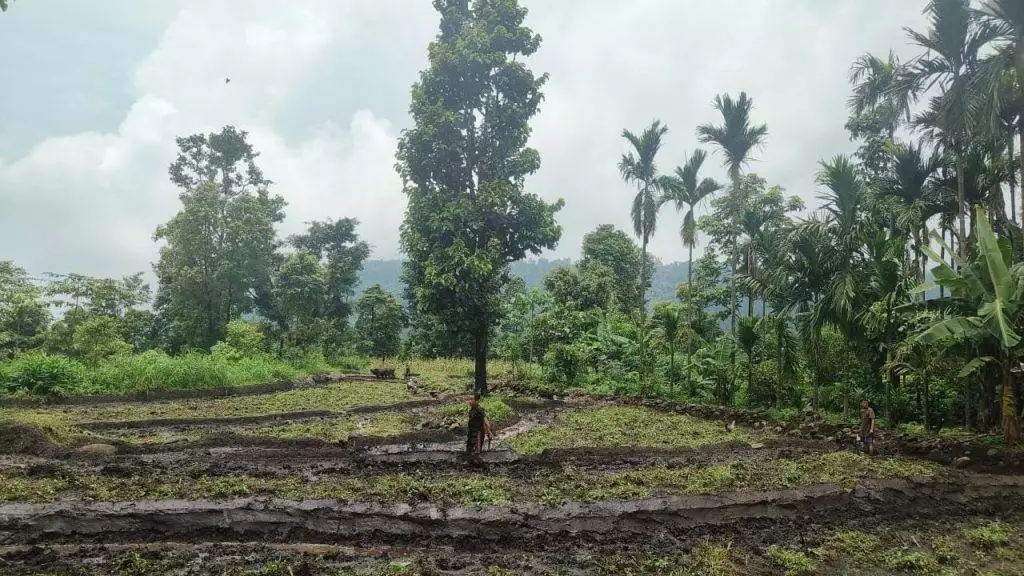
Travel tips to Parengtar, Kalimpong Distict:
Best to hire a taxi from Siliguri or in advance book through your local host to have a local taxi pick you up. The road repairs are ongoing so parts of the roads are not in good shape. Monsoon season there is magical but roads to Siliguri can get blocked if the Teestha river is in spate and the region is prone to minor landsldes. For those who don’t fancy being in rain pants and gum boots on a holiday or the trials of travelling in the rains , I suggest spring time March to May as the orchids will be in bloom. Great countryside for treks of different moderations, durations and scenic picnics. I recommend hiring a local guide to assist you both for the treks ad local cultural experiences which can range from an authentic Nepali meal in a rustic home, trying your hand at farming and an indigenous music performance. There are a mixed range of accommodation available to choose from to suit your budget.

